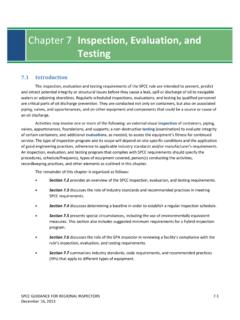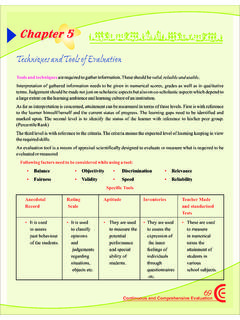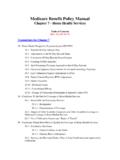Transcription of Planning, Implementing, and Evaluating an …
1 3822 GPO Page 178:31 AM 7/26/02 chapter One planning , implementing , and Evaluating an Intervention An Ov erview 3822 GPO Page 198:31 AM 7/26/02 chapter 1 - 5 planning , implementing , and Evaluating an Intervention An Overview Introduction planning , implementing , and Evaluating an intervention can be a daunting project, especially for someone who has never been involved in such an effort. However, you can improve your chances of success if you follow certain steps. This chapter gives a brief overview of those steps. In this chapter , we will explain how and why to do the following: Describe the problem of youth violence in your community Identify intended participants for an intervention Identify possible settings in which to reach intended participants Set goals and objectives Select an intervention or multiple interventions that will most appropriately address your goals and objectives and meet the needs of your participants Locate resources for your intervention Involve the community in your effort Develop activities and materials for your intervention Hire and train staff Monitor your intervention s progress Evaluate the success of your intervention If after reading this chapter , you have questions or concerns about developing an intervention for your community, take a look at the Additional Resources section at the end of the chapter .
2 The publications listed there contain helpful information about such topics as assessing a community s resources and readiness to change, working with diverse populations, and Evaluating a program. Definitions You will see the terms strategy, intervention, and program repeated many times throughout this sourcebook. Because these terms may mean slightly different things to people in different professions, we have defined them here so all readers will know how they are used in this publication. Strategy: A general conceptual approach to preventing violence by children and adolescents. For example, home visiting can offer basic training in parenting skills for pregnant teens. 3822 GPO Page 208:31 AM 7/26/02 6 - chapter 1 Intervention: A specific set of activities and accompanying materials developed to prevent youth violence and the factors that contribute to it. For example, a school may implement a curriculum and role-playing activities to help students develop conflict-resolution skills.
3 Program: A grouping of strategies (and, therefore, of various kinds of interventions) designed to prevent youth violence. For example, a community might combine a school-based curriculum with a home-visiting intervention. Describe the Problem Before you can plan an intervention to prevent violence committed by children and adolescents in your community, you need an accurate description of the problem. This description will help you identify who is affected most by the problem and where the problem occurs most frequently so you can better target an intervention. It will guide you in developing realistic objectives for your intervention and will provide a baseline against which to measure progress. You also need a clear definition of the problem to convince lawmakers, community leaders, parents, volunteers, and potential funders that your intervention is necessary. The information you need to describe the problem can be obtained from several sources. Quantitative data is available from a number of agencies and organizations that collect statistics on youth violence, and you can interview or survey members of your community to get qualitative information ( , opinions, attitudes).
4 Regardless of where you get your information, be sure the individuals collecting it are respected and trusted by the community. Factual information Many sources of data exist to help you define the problem of youth violence in your community. Table 1 lists some of those sources. Appendix A at the end of this sourcebook also provides data about youth violence at a national level. Before asking agencies and organizations for information, do a little research. Table 1 Sources of Factual Information about Youth Violence Police records Vital statistics division of state or local health department Medical examiner Hospital or emergency department records Outpatient records from public or private clinics Emergency medical service (ambulance) records School nurse s records, attendance records, and records of disciplinary infractions Youth risk behavior surveys (see Additional Resources for details) Federal agencies (see Additional Resources for details) Before you plan an intervention to prevent violence committed by children and adolescents in your community, you need an accurate description of the problem.
5 3822 GPO Page 218:31 AM 7/26/02 chapter 1 - 7 Once you know how many young people committed violent acts, when and where the acts took place, and what circumstances surrounded those acts, you may want to find out about factors in your community that could contribute to violence. Find out what information each entity has and limit your request to that information. Don t send out one blanket request to several agencies, hoping to find information you need. Because information about children and adolescents who commit violent acts is often kept confidential, you may have to get summary data. Summary data provide the statistics without any information that could identify the people involved. If you are working with a research organization or university, its staff should know how to get legal access to records. Once you know how many young people committed violent acts, when and where the acts took place, and what circumstances surrounded those acts, you may want to find out about factors in your community that could contribute to violence.
6 Examples of contributing factors include racism, poverty, unemployment, and other social, cultural, or economic conditions. Some of this information can be obtained from the Census (available through your local library), the Department of Labor s employment statistics, and the Department of Housing and Urban Development. Opinions from community members How do members of your community perceive the problem of youth violence, and what do they think is causing it? To find out, survey residents, community leaders, school personnel, legal and police personnel, health workers, and parents. For example, ask school principals and guidance counselors about violence they see in the schools and listen to their ideas for reducing it. Talk to young people, particularly those who might be in trouble or at risk for trouble (for example, those who are expelled from school). Contact the youths and their parents at home and in as many community sites as possible, including supermarkets, shopping centers, basketball courts and other recreational areas, churches, and schools.
7 Local colleges and universities may be able to help with opinion surveys. Opinion surveys and interviews are valuable because they help you collect information that does not appear in the statistics. The survey responses help assess community members beliefs, knowledge, and attitudes about youth violence. They may also identify social norms and determine community priorities. And you may learn about ideas for possible interventions. Data interpretation The data you obtain from statistical reports and opinion surveys may need to be analyzed and interpreted before you can use it. Enlist a statistician or other expert to help make your data easy 3822 GPO Page 228:31 AM 7/26/02 8 - chapter 1 to understand before you present it to community leaders. After you have the data about your community, compare it with that of your state and the ove rall. This comparison will provide community leaders with some perspective. Select Intended Participant Groups An intended participant group is the group of people your intervention is designed to influence.
8 The data you collected about your community will guide your decision about whom to target. This group may be general or specific, depending on the youth violence problem in your community and the resources available to address it. Ta ble 2 lists potential participant groups. General population of children and adolescents Interventions directed at all children in a community typically require a lot of resources and, therefore, can be very expensive. The benefit of these broad interventions is that you reach a large number of young people with violence-prevention messages. The down side is that they may not affect high-risk youth as much as targeted interventions. At-risk and high-risk children and adolescents Research has shown that certain factors make children and adolescents more susceptible to developing violent behavior. These factors include an individual s characteristics or behaviors, including a history of aggression; beliefs that support the use of violence; social or cognitive problems; and the use of alcohol or drugs.
9 They also include family and community circumstances such as a parent s use of alcohol or drugs; a lack of parental supervision or discipline; spousal abuse or child abuse; poor emotional attachment between parent and child; access to firearms; and divo rce, relocation, or other family disruption. Problems at school, such as chronic discipline problems and associating with peers who are violent, can also put a young person at risk for developing violent behavior (Dahlberg 1998). 3822 GPO Page 238:31 AM 7/26/02 chapter 1 - 9 Table 2 Potential Participant Groups for Interventions to Prevent Youth Violence All children and adolescents in a community All children in a specific age group, school, grade Children and adolescents with risk factors such as use of alcohol or other drugs history of early aggression social or learning problems exposure to violence at home, in their neighborhood, or in the media parental drug or alcohol use friends who engage in problem behavior academic failure or poor commitment to school poverty recent divo rce, relocation.
10 Or other family disruption access to firearms Children and adolescents with high-risk behaviors such as criminal activity fighting or victimization drug or alcohol abuse selling drugs carrying a weapon membership in a gang dropping out of school unemployment homelessness recent immigration Parents and other family members Influential adults such as teachers coaches child care providers General population of a community 3822 GPO Page 248:31 AM 7/26/02 10 - chapter 1 High-risk individuals are those who consistently engage in physical fights to resolve problems, have a criminal record, have a history of inflicting violent injury, have been the victim of violence, have failed or dropped out of school, carry a weapon, belong to a gang, or use drugs. Children and adolescents who move a lot, including children of immigrants or migrant workers, are also considered high risk. If you choose to target at-risk or high-risk groups, be prepared for special challenges. You may need to enlist outreach workers to locate and engage high-risk youths, many of whom are no longer in school.
















